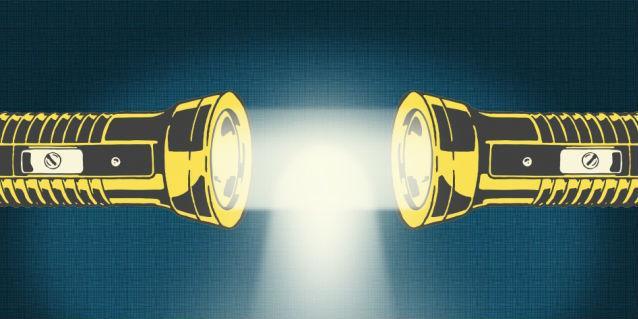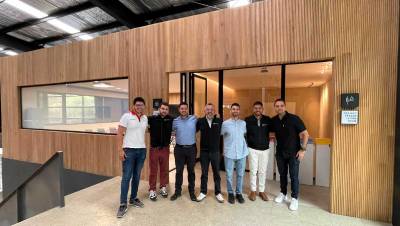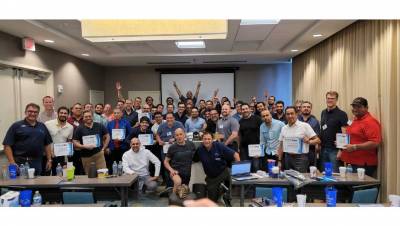 International. Scientists from MIT and Harvard University conducted research in which they created a new form of light. The following is the research report published by MIT.
International. Scientists from MIT and Harvard University conducted research in which they created a new form of light. The following is the research report published by MIT.
Try a quick experiment: take two flashlights in a dark room and turn them on so that their beams of light cross. Did you notice anything peculiar? The common answer is, probably not. That's because the individual photons that make up light don't interact. Instead, they simply intersect, like indifferent spirits at night.
But what if light particles could interact, attract, and repel each other like atoms in ordinary matter? A tempting, if sci-fi possibility: lightsabers: rays of light that can pull and push each other, creating dazzling epic clashes. Or, in a more likely scenario, two beams of light could meet and merge into a single light current.
It may seem that such optical behavior would require bending the rules of physics, but in fact, scientists at MIT, Harvard University and elsewhere have shown that photons can interact, an achievement that could open the way to the use of photons in quantum computing, if not lightsabers.
A paper published in the journal Science, the team, led by Vladan Vuletic, Professor of Physics Lester Wolfe at MIT, and Professor Mikhail Lukin of Harvard University, reported that they have observed clusters of three photons interacting and, in effect, sticking together to form an entirely new type of photonic matter.
In controlled experiments, the researchers found that when a very faint laser beam shone through a dense cloud of ultracold rubidium atoms, rather than leaving the cloud as single, randomly spaced photons, the photons joined into pairs or triplets, suggesting some kind of interaction, in this case, attraction, that takes place between them.
While photons normally have no mass and travel at 300,000 kilometers per second (the speed of light), the researchers found that bound photons actually acquired a fraction of the mass of an electron. These newly weighed light particles were also relatively slow, traveling about 100,000 times slower than normal photons that don't interact.
Vuletic said the results show that photons can attract or entangle each other. If they can be made to interact in other ways, photons can be harnessed to perform extremely fast and incredibly complex quantum computations. "The interaction of individual photons has been a very long dream for decades," he said.
Vuletic co-authors include Qi-Yung Liang, Sergio Cantu and Travis Nicholson of MIT, Lukin and Aditya Venkatramani of Harvard, Michael Gullans and Alexey Gorshkov of the University of Maryland, Jeff Thompson of Princeton University and Cheng Ching of the University of Chicago.
Vuletic and Lukin run the MIT-Harvard Center for Ultracold Atoms, and together they have been looking for ways, both theoretical and experimental, to foster interactions between photons. In 2013, the effort paid off, as the team observed pairs of photons interacting and bonding for the first time, creating an entirely new state of matter.
In their new work, the researchers wondered if interactions could take place not just between two photons, but more.
"For example, you can combine oxygen molecules to form O2 and O3 (ozone), but not O4, and for some molecules you can't form even one three-particle molecule," Vuletic explained. "So, it was an open question: can you add more photons to a molecule to make bigger and bigger things?"
To find out, the team used the same experimental approach they used to observe the interactions of two photons. The process begins with cooling a cloud of rubidium atoms to ultracold temperatures, just one-millionth of a degree above absolute zero. By cooling the atoms, it slows them down to almost stop. Through this cloud of immobilized atoms, the researchers then shine with a very weak laser beam, so faint, in fact, that only a handful of photons travel through the cloud at any one time.
The researchers then measure the photons as they leave the other side of the atomic cloud. In the new experiment, they found that photons flowed as pairs and triplets, rather than leaving the cloud at random intervals, like isolated photons that have nothing to do with each other.
In addition to tracking the number and velocity of photons, the team measured the phase of the photons, before and after they traveled through the atomic cloud. The phase of a photon indicates its frequency of oscillation.
"The phase tells you how strongly they are interacting, and the larger the phase, the stronger they are bonded," Venkatramani said. The team observed that when three-photon particles left the atomic cloud simultaneously, their phase shifted compared to what they had when photons did not interact, and was three times larger than the phase shift of two-photon molecules. "This means that these photons not only interact independently of each other, but also interact together."
Memorable encounters
The researchers then developed a hypothesis to explain what may have caused the photons to interact in the first place. His model, based on physical principles, presents the following scenario: when a photon moves through the cloud of rubidium atoms, it briefly lands on a nearby atom before jumping to another atom, like a bee fluttering between flowers, until it reaches the other end.
If another photon travels simultaneously through the cloud, it can also spend some time in a rubidium atom, forming a polariton, a hybrid that is part of the photon, part of the atom. Then, two polaritons can interact with each other through their atomic component. At the edge of the cloud, the atoms remain where they are, while the photons come out, still bonded. The researchers found that this same phenomenon can occur with three photons, forming an even stronger bond than interactions between two photons.
"What was interesting was that these triplets formed at all," Vuletic added. "It was also not known whether they would have an equal, lower or stronger limit compared to photon pairs."
All interaction within the atomic cloud occurs more than a millionth of a second. And it's this interaction that causes the photons to stay together, even after they left the cloud.
"The good thing about this is that when photons go through the medium, whatever happens in the middle, they 'remember' when they come out," Cantu said.
This means that photons that have interacted with each other, in this case through an attraction between them, can be considered strongly correlated or entangled, a key property for any quantum computing bit.
"Photons can travel very fast over long distances, and people have been using light to transmit information, like in optical fibers," Vuletic said. "If photons can influence each other, then if you can entangle these photons, and we have, you can use them to distribute quantum information in an interesting and useful way."
In the future, the team will look for ways to force other interactions, such as repulsion, where photons can spread to each other like billiard balls.
"It's completely novel in the sense that we don't even know sometimes qualitatively what to expect," Vuletic concluded. "With the repulsion of photons, can they be such that they form a regular pattern, like a crystal of light? Or will something else happen? It's very unknown territory."
The research was supported in part by the National Science Foundation.


























Leave your comment